The Woman in Red

Brief Synopsis
Cast & Crew
Robert Florey
Barbara Stanwyck
Gene Raymond
Genevieve Tobin
Russell Hicks
Nella Walker
Film Details
Technical Specs

Synopsis
Shelby Barrett, a prize-winning equestrienne, competes for the stables of a snobbish society woman named Nicko Nicholas. Shelby's strongest challenger is Eugene Fairchild, a wealthy horseman who rides his own entries and is in love with Shelby. When Johnny Wyatt, an upperclass gigolo, visits Nicko, he, too, falls in love with Shelby. Nicko, jealous of Johnny's interest in Shelby, fires her, which only encourages the couple to marry. Johnny takes Shelby home to Wyattsville, where she is coldly received by his family, who look down on the working class. Shelby attempts to establish Johnny in business, and goes to Eugene to borrow money to open a stable. Eugene invites her to a party on his yacht, during which Shelby witnesses the accidental drowning of a guest named Olga. Eugene is arrested for murder, and Shelby, afraid of scandal, withholds her testimony. When she finally testifies to Eugene's innocence, she is discredited and accused of adultery. The Wyatts defend her, but it is only to protect the family name. Eugene proposes she divorce Johnny and marry him, but she admits that she still loves her husband. Despite the pressures, Johnny forgives Shelby and chooses her love over his family's acceptance.

Director

Robert Florey
Cast

Barbara Stanwyck

Gene Raymond

Genevieve Tobin
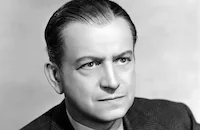
Russell Hicks

Nella Walker

Claude Gillingwater
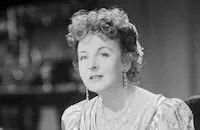
Doris Lloyd

Hale Hamilton

Ed Van Sloan

Brandon Hurst
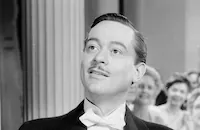
John Eldredge

Phillip Reed

Dorothy Tree

Arthur Treacher
Gunnis Davis
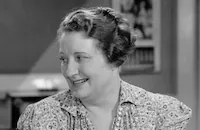
Ann Shoemaker
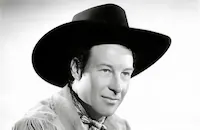
Gordon Elliott
Fred Vogeding
Eleanor Wesselhoeft
Jan Buckingham
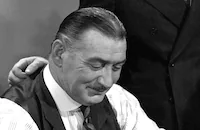
Edward Keane
Marcoreta Hellmen
Rose Allen Castlen
Jack Mulhall
Harry Tyler
Robert E. Homans
Arthur Aylesworth
Eddie Shubert
Harry Seymour
Edward Le Saint
Franklin Parker
Phil Tead
Olive Jones
George Chandler
William R. Arnold
George Riley
Landers Stevens
Evelyn Wynans
Crew
Harry Joe Brown
Leo F. Forbstein
Esdras Hartley
Stanley Logan
Mary Mccall Jr.
Peter Milne
Terry Morse
Orry-kelly
Sol Polito
L. Reginald
Jack Sullivan
Joe Young

Videos
Movie Clip


Trailer
Film Details
Technical Specs

Articles
The Woman in Red
Barbara Stanwyck to Genevieve Tobin in The Woman in Red
Barbara Stanwyck was the kind of actress who elevated every film in which she appeared, however strong or weak the material. Give her one scene she could play honestly -- be it comic, romantic or a fiery dressing down like the one she gives Genevieve Tobin in this 1935 romance -- and she would have the audience in the palm of her hand. Although the script The Woman in Red has little to elevate above the ranks of other romances turned out at the time, designed simply to showcase a strong leading lady in glamorous costumes and emotional scenes, she gives it her all, turning into one in a career of tour de forces.
The story has all the elements of what would later be labeled the "woman's picture" -- life in the horsey set, a romance crossing class boundaries, jilted lovers and snobby in-laws. Stanwyck stars as a championship rider who falls into the arms of broken-down polo player Gene Raymond despite her romance with nouveau riche John Eldredge and his with married socialite Genevieve Tobin. With the vengeful Tobin out for blood and Raymond's greedy family wanting him to dump his bride and get back with his wealthy mistress, this is one marriage that's in for a bumpy ride. But the bumps are what give Stanwyck her chance to shine, as she tells off everyone in sight, particularly her husband's family and former love. Throw in a momentary indiscretion followed by a tearful apology, and you have the perfect recipe for a female star vehicle, 1935 edition.
If Stanwyck threw herself into the dramatics with abandon, she had personal and professional reasons. Personally, the film provided an escape from her problems at home with first husband Frank Fay. As her career had risen, his had declined. During filming, he had a falling out with MGM general studio manager Eddie Mannix at the Brown Derby. He was drinking a lot and at times lashed out at Stanwyck physically. He also took to calling studio head Jack Warner during filming to complain about his wife's being away from home for long hours making the picture. With other leading ladies under contract, Warner decided to suspend Stanwyck's contract rather than deal with Fay any more. Realizing he was harming her career and not willing to undergo any more physical abuse, Stanwyck filed for divorce within a year. She rarely had a kind word for him in later life and disinherited their adopted son, Dion, when he tried to reach out to his father in later years.
The end of Stanwyck's contract with Warner Bros. was not necessarily a bad thing. She had made some good films there, most notably three with director William A. Wellman -- Night Nurse (1931), So Big! (1932) and The Purchase Price (1932) -- but she also had made a lot of programmers. And she could tell the studio was beginning to favor other actresses. Although she had played the plum, decades-spanning role of Selina Peake in So Big!, with new contract player Bette Davis in a small supporting role, she only got the lead in The Woman in Red because Davis couldn't or wouldn't do it. The studio had bought the rights to Wallace Irwin's 1932 novel North Shore with Davis in mind. Once Stanwyck finished her Warner's contract, she never signed another long-term contract, preferring to freelance the rest of her career.
It probably didn't help that director Robert Florey was primarily a B-movie helmer. Although he had done some fascinating avant-garde shorts, like The Life and Death of 9413, a Hollywood Extra (1928) and worked briefly at UFA, his loss of the chance to direct Frankenstein (1931) at Universal consigned him to programmers for most of his career. Even on a budget, he had a strong visual sense, as evidenced by his work on Murders in the Rue Morgue (1932), with Bela Lugosi. Although he could hardly have imitated that film's expressionistic style on a simple romance like The Woman in Red, he still gave the film a lush look and, in keeping with Warner's house style, kept the action moving along quickly.
Director: Robert Florey
Screenplay: Wallace Irwin (novel); Mary C. McCall Jr., Peter Milne
Cinematography: Sol Polito
Art Direction: Esdras Hartley
Music: Bernhard Kaun (uncredited)
Film Editing: Terry Morse
Cast: Barbara Stanwyck (Shelby Barret Wyatt), Gene Raymond (John 'Johnny' Wyatt), Genevieve Tobin (Mrs. 'Nicko' Nicholas), John Eldredge (Eugene 'Gene' Fairchild), Phillip Reed (Dan McCall), Dorothy Tree (Mrs. Olga Goodyear), Russell Hicks (Defense Attorney Clayton), Nella Walker (Aunt Bettina), Claude Gillingwater (Grandpa Wyatt), Doris Lloyd (Mrs. Casserly)
BW-69m.
by Frank Miller

The Woman in Red
Quotes
Trivia
Notes
The film's working title was North Shore. According to Daily Variety, Bette Davis was considered for the lead role. According to the Warner Bros. files, Joel McCrea, Robert Young and Ricardo Cortez were considered for leading roles. The Motion Picture Herald review lists the release time as 80 min. but this is probably an error. Modern sources add the following information about the production: The racing scenes were shot by second unit director William McBann at the San Pedro Breakfast Club; William B. Davidson (Goodyard), Nan Grey and Dave O'Brien are listed as being in the cast; and Marcoreta Hellmen is credited as technical advisor.















